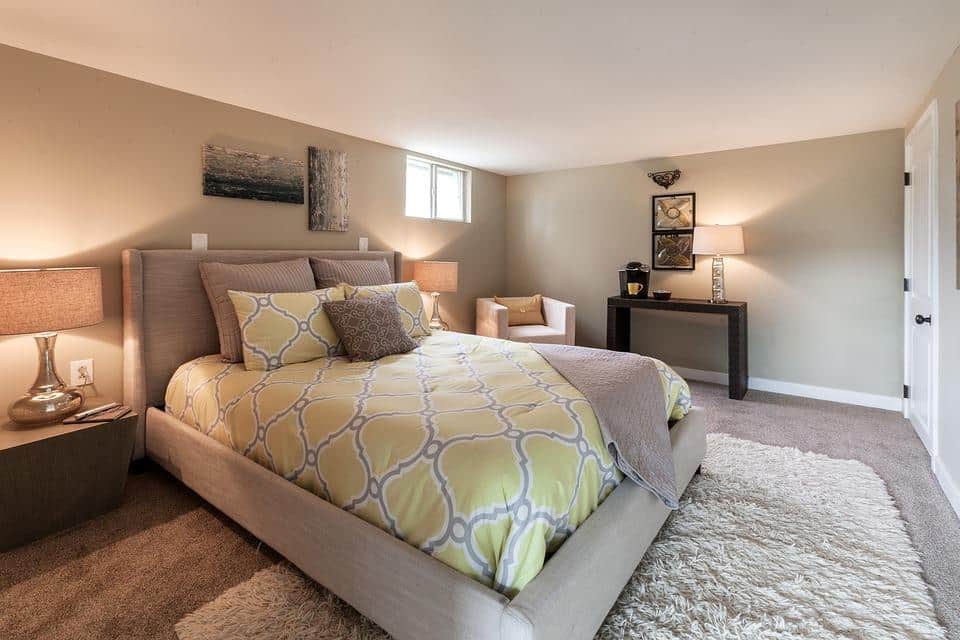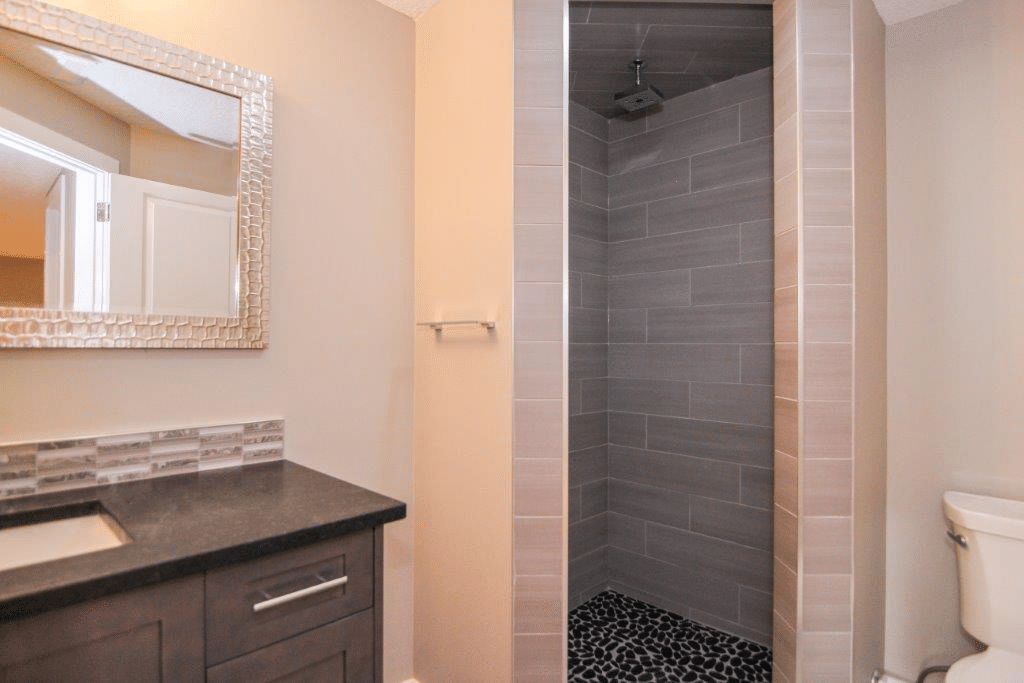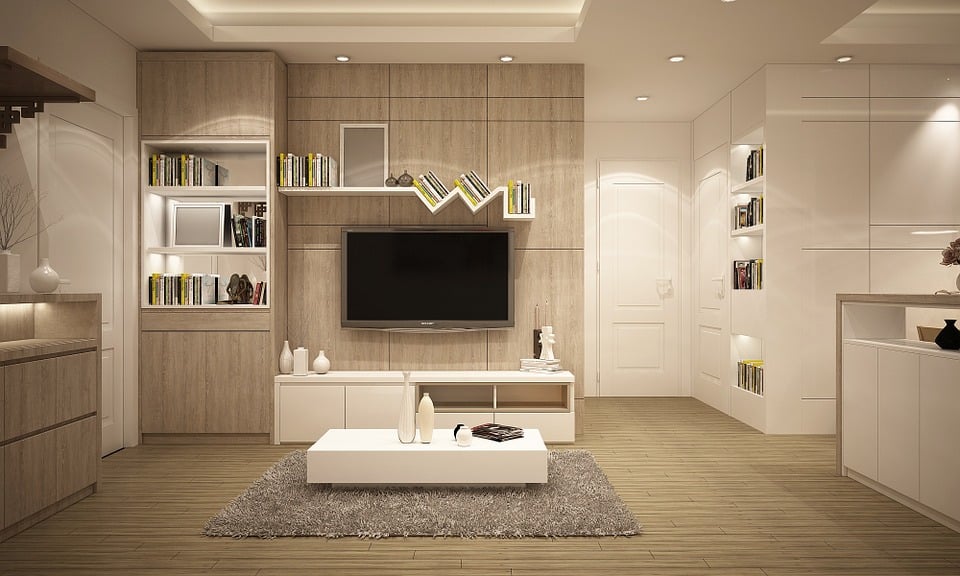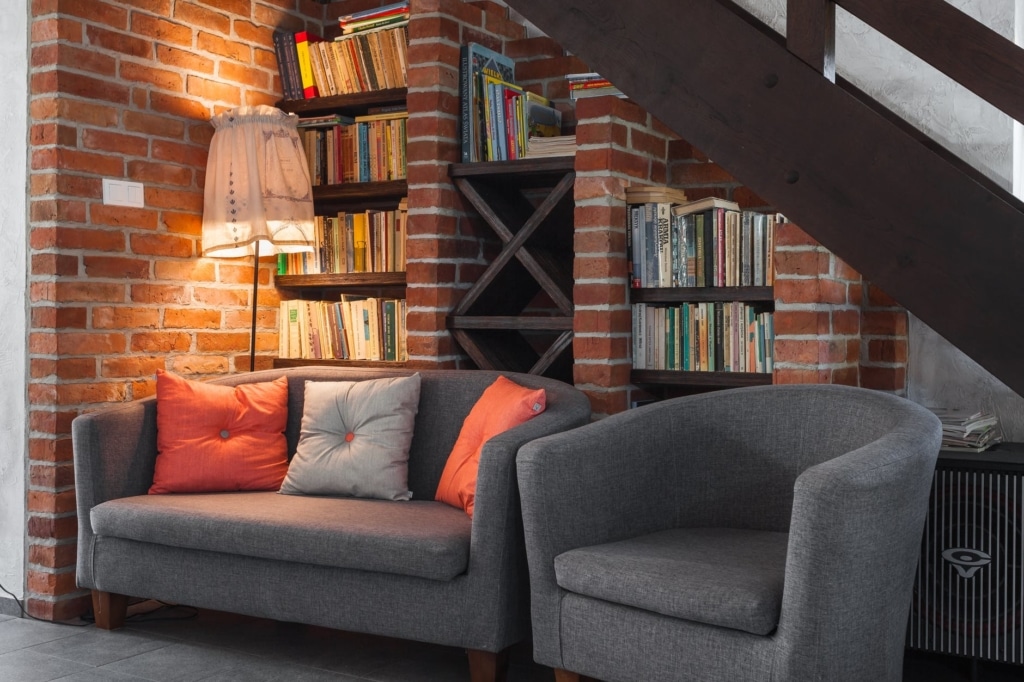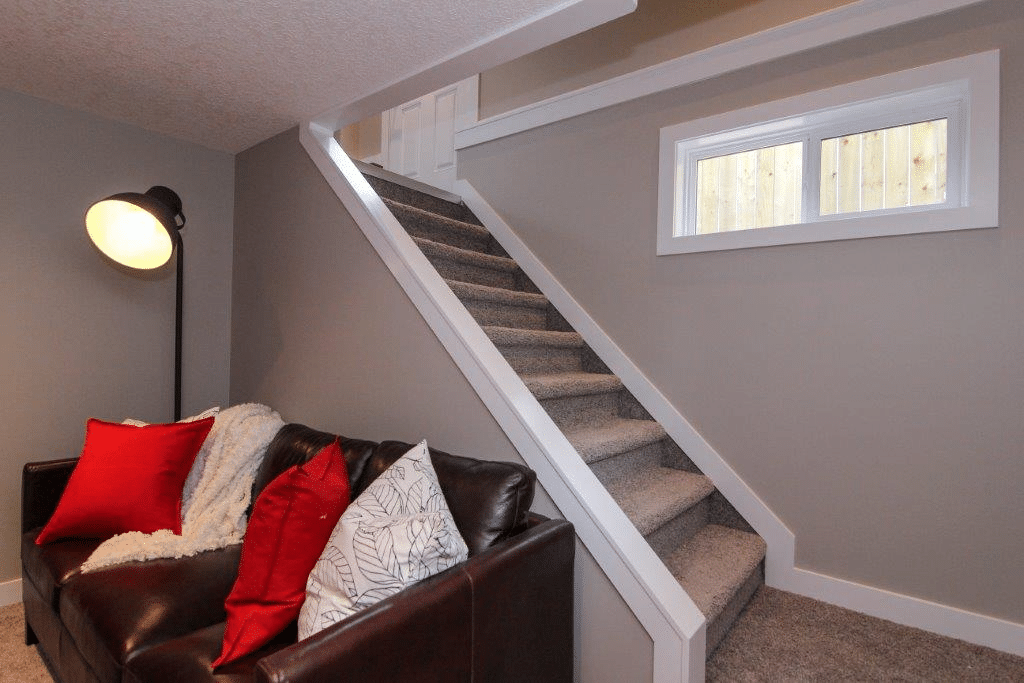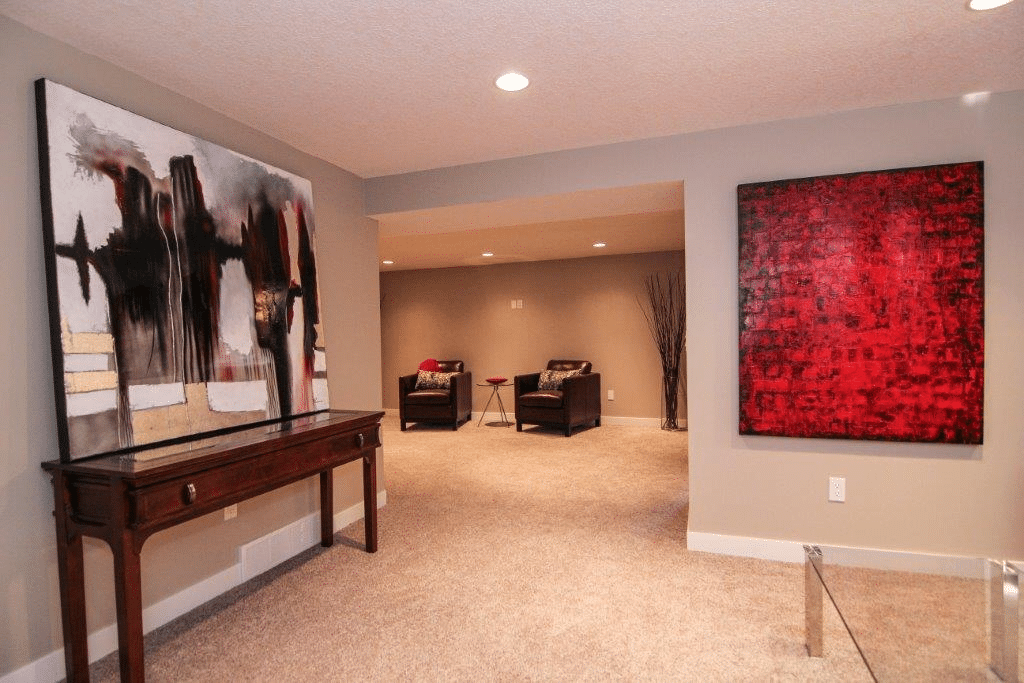When doing basement renovations, the ceiling is often an overlooked element that can significantly impact the space’s overall look, feel, and functionality. The right ceiling choice can transform a dark, unfinished basement into a welcoming and stylish area that complements the rest of your home. This article will explore various ceiling options, including drop ceilings, drywall ceilings, beadboard, exposed ceilings, coffered ceilings, acoustic ceilings, tin ceilings, corrugated metal ceilings, and painted ceilings. Each type has its unique advantages and drawbacks, making it essential to choose one that aligns with your specific needs and aesthetic preferences.
Table of Contents
ToggleBasement Renovations – Types of Ceilings
Drop Ceilings (Suspended Ceilings)
Drop ceilings, also known as suspended ceilings, are a popular choice for basements due to their practicality and versatility. These ceilings are constructed by suspending a grid system from the existing ceiling joists, into which tiles or panels are inserted. This setup allows for easy access to plumbing, electrical wiring, and HVAC systems, making it a convenient option for basements where utilities may need occasional maintenance or updates.
One of the main advantages of drop ceilings is the wide range of styles and finishes available. Homeowners can choose from various materials, including mineral fiber, metal, or vinyl, each offering different levels of sound absorption and aesthetic appeal. Drop ceilings can also incorporate lighting fixtures seamlessly, contributing to the overall ambiance of the basement.
However, drop ceilings do have some drawbacks. The installation process can reduce the overall ceiling height by several inches, which may be a concern in basements with already low ceilings. Additionally, while there are many decorative options, some homeowners find that drop ceilings lack the polished appearance of more traditional ceiling types.
Drop ceilings are best suited for basements with numerous utilities running above or for those who prioritize easy access to these systems. They offer a balance between functionality and aesthetics, making them a practical choice for many basement renovations.
Drywall Ceilings
Drywall ceilings are a classic and versatile option when competing basement renovations, providing a clean, smooth finish that can be painted to match any decor. This type of ceiling is constructed by attaching sheets of drywall directly to the ceiling joists, creating a seamless look that can make the basement feel like an extension of the rest of the home. Drywall ceilings are particularly popular in basements where a cohesive design is desired.
One of the key benefits of drywall ceilings is their excellent soundproofing capabilities. The solid structure of the drywall helps to muffle noise from the floor above, creating a quieter and more private space in the basement. Additionally, drywall ceilings can be finished with a variety of textures or left smooth, allowing for customization to suit any style preference.
However, drywall ceilings come with certain disadvantages. They are a more permanent solution, meaning that accessing utilities hidden above the ceiling can be challenging and may require cutting into the drywall. This can lead to additional repairs and maintenance over time. Furthermore, achieving a flawless finish often requires professional installation, which can add to the overall cost of the renovation.
Drywall ceilings are best suited for basements where aesthetics are a priority and where access to utilities is not a frequent concern. They offer a sleek, polished appearance that can enhance the overall feel of the space.
Beadboard Ceilings
Beadboard ceilings are an excellent choice for homeowners looking to add texture and character to their basement. This type of ceiling consists of narrow wooden planks with a distinctive ridge or bead running along the length of each board. When installed, beadboard creates a charming, classic look that can evoke a cottage or coastal feel, making it ideal for basements with a more traditional or rustic decor theme.
One of the primary advantages of beadboard ceilings is their versatility. They can be painted in any color, allowing homeowners to match the ceiling to the overall color scheme of the basement. Additionally, beadboard is relatively easy to install, especially in comparison to more complex ceiling options like coffered ceilings. This makes it a popular choice for DIY enthusiasts or those looking to keep renovation costs down.
However, beadboard ceilings do have some limitations. The intricate design can be more challenging to clean, as dust and grime can accumulate in the grooves of the boards. Furthermore, beadboard may not be the best fit for modern or minimalist designs, where a more streamlined and simple ceiling might be preferred. The wood material can also be susceptible to moisture, which is an important consideration in basements that may be prone to dampness.
Beadboard ceilings are best suited for basements that aim to achieve a warm, inviting atmosphere with a touch of traditional charm. They provide a unique aesthetic that can set the tone for the entire space, making them a favorite for those looking to add character to their basement renovation.
Exposed Ceilings
Exposed ceilings offer a bold and unconventional approach to basement design, where the ceiling structure—beams, ducts, pipes, and all—is left uncovered. This style is particularly popular in industrial and modern aesthetics, where the raw, unfinished look adds a sense of authenticity and edge to the space. Exposed ceilings can give a basement a loft-like feel, making it appear more spacious and open.
One of the biggest advantages of exposed ceilings is their practicality. By leaving the ceiling open, homeowners have easy access to utilities for maintenance, repairs, or future upgrades. This accessibility can save time and money in the long run, as there is no need to cut into drywall or remove ceiling tiles. Additionally, the exposed structure can be painted or treated to enhance its visual appeal, allowing for some level of customization.
Despite their unique appeal, exposed ceilings are not without drawbacks. The open design can make the basement feel unfinished or less cozy, which might not be ideal for every homeowner. Moreover, exposed ceilings offer little in terms of soundproofing, as there are no materials to absorb noise from the floor above. This can be a concern in multi-story homes where basement noise might travel easily to other living spaces.
Exposed ceilings are best suited for basements that embrace an industrial or modern design ethos and for those who value easy access to utilities. They are a cost-effective solution that can create a striking visual impact, though they may require additional measures to address noise and insulation concerns.
Coffered Ceilings
Coffered ceilings bring a touch of elegance and sophistication to basement renovations. This type of ceiling features a grid of recessed panels, often adorned with molding or trim, creating a three-dimensional effect that adds depth and architectural interest to the space. Coffered ceilings are commonly associated with high-end homes and can elevate the basement from a functional space to a luxurious retreat.
The primary advantage of coffered ceilings is their aesthetic appeal. The grid pattern and decorative details can be customized to suit various design styles, from traditional to contemporary. Coffered ceilings also have the potential to make the basement feel taller and more spacious, as the recessed panels create an illusion of height. This makes them particularly effective in basements with low ceilings, where maximizing visual space is important.
However, coffered ceilings are among the more expensive and labor-intensive options available. The intricate design and construction process require skilled craftsmanship, which can significantly increase the cost of the renovation. Additionally, coffered ceilings may not be practical for all basements, particularly those with limited ceiling height or irregular layouts, as the grid pattern needs to be carefully planned and executed.
Coffered ceilings are best suited for basements where a touch of luxury is desired, and where the budget allows for a more elaborate ceiling treatment. They are an excellent choice for creating a statement in the space, transforming an ordinary basement into an extraordinary living area.
Acoustic Ceilings
Acoustic ceilings are designed with soundproofing in mind, making them an ideal choice for basements that serve as home theaters, music rooms, or other spaces where noise control is a priority. These ceilings are typically constructed using specialized acoustic tiles or panels that absorb sound and reduce echo, creating a quieter and more comfortable environment.
One of the key benefits of acoustic ceilings is their effectiveness in managing sound. The materials used in these ceilings are specifically engineered to dampen noise, making them a popular choice for multi-purpose basements that may experience varying levels of activity. Acoustic ceilings can also contribute to better sound quality within the space, which is particularly important for home theaters or recording studios.
In addition to their functional benefits, acoustic ceilings come in a variety of styles and finishes, allowing homeowners to choose a design that complements the overall aesthetic of the basement. Some acoustic tiles are available in decorative patterns or colors, providing an opportunity to blend practicality with visual appeal.
However, acoustic ceilings can be more expensive than standard drop ceilings, particularly if high-end materials are used. Additionally, while there are many decorative options available, some homeowners may find that acoustic ceilings do not align with their desired aesthetic, especially if they prefer a more seamless or traditional look.
Acoustic ceilings are best suited for basements where sound control is essential, such as in entertainment or music-focused spaces. They offer a balance of functionality and design, ensuring that the basement is both comfortable and stylish.
Tin Ceilings
Tin ceilings are a timeless option that adds a touch of vintage charm to any basement. These ceilings are typically made from pressed metal panels, often featuring intricate patterns and designs that hark back to the late 19th and early 20th centuries. Tin ceilings can be a focal point in a basement, lending an air of elegance and history to the space.
One of the main advantages of tin ceilings is their durability. Tin panels are resistant to moisture and mold, making them a practical choice for basements, which can sometimes be prone to damp conditions. The reflective surface of tin ceilings can also help to enhance lighting in the basement, making the space feel brighter and more open.
In addition to their functional benefits, tin ceilings offer a wide range of design possibilities. They can be left in their natural metallic finish for a more traditional look or painted in any color to match the decor of the basement. This versatility allows homeowners to customize the ceiling to their exact specifications, whether they prefer a classic or contemporary style.
However, tin ceilings can be more expensive than other ceiling options, particularly if custom designs or finishes are chosen. The installation process can also be complex, often requiring professional assistance to ensure that the panels are properly aligned and secured. Additionally, tin ceilings may not be suitable for every decor style, as their ornate designs may clash with more modern or minimalist aesthetics.
Tin ceilings are best suited for basements that aim to achieve a vintage or ornate look. They provide a unique and durable option that can elevate the overall design of the space, making them a favorite for homeowners looking to add a touch of history to their basement renovation.
Corrugated Metal Ceilings
Corrugated metal ceilings are an innovative choice for homeowners seeking a distinctive, industrial look in their basement. These ceilings are made from sheets of corrugated metal, typically aluminum or steel, which are installed to create a wave-like texture that adds visual interest and dimension to the space. Corrugated metal ceilings are often associated with modern, rustic, or industrial design styles.
One of the main benefits of corrugated metal ceilings is their durability. The metal is resistant to moisture, mold, and pests, making it a practical choice for basements that may be exposed to damp conditions. The reflective nature of the metal also helps to enhance lighting in the space, contributing to a brighter and more open atmosphere.
In terms of aesthetics, corrugated metal ceilings offer a unique and bold look that can serve as a statement piece in the basement. They are ideal for homeowners looking to create an edgy, modern space with a touch of industrial flair. The metal can be left in its natural finish for a more rugged look or painted to match the overall color scheme of the basement.
However, corrugated metal ceilings do have some disadvantages. The metal can create noise issues, particularly if not properly insulated, as it can amplify sounds rather than dampen them. Additionally, the industrial look may not be suitable for all design preferences, especially in basements that aim for a more traditional or cozy feel. The installation process can also be more complex than other ceiling options, often requiring professional assistance.
Corrugated metal ceilings are best suited for basements with an industrial, rustic, or contemporary decor theme. They provide a durable and visually striking option that can set the tone for the entire space, making them a popular choice for those looking to make a bold design statement.
Painted Ceilings
Painted ceilings offer a simple and cost-effective solution for basement renovations, providing homeowners with the opportunity to customize the space without the need for extensive construction. Whether the ceiling is drywall, exposed beams, or pipes, a fresh coat of paint can dramatically change the look and feel of the basement.
One of the primary advantages of painted ceilings is their versatility. Homeowners can choose any color to match the decor of the basement, from light, bright shades that make the space feel larger and more open to darker tones that create a cozy, intimate atmosphere. Paint can also be used to create special effects, such as a faux finish or mural, adding a unique touch to the ceiling.
In addition to their aesthetic benefits, painted ceilings are a budget-friendly option for basement renovations. The cost of paint and supplies is relatively low, making it an accessible choice for those looking to update their basement without a significant financial investment. Painted ceilings are also easy to maintain, with touch-ups or color changes being straightforward and inexpensive.
However, painted ceilings do have some limitations. They do not offer any soundproofing or insulation, which may be a concern in basements where noise control is important. Additionally, painted ceilings require regular maintenance to keep them looking fresh and free of scuffs or marks. The lack of a finished structure can also make the basement feel less polished compared to other ceiling options.
Painted ceilings are best suited for basements on a budget or those looking for a simple, clean aesthetic. They offer a flexible and affordable option that can be easily updated or changed over time, making them a practical choice for many homeowners.
Conclusion
Choosing the right ceiling for your basement is a crucial step in the renovation process. Each type of ceiling—whether it’s drop ceilings, drywall, beadboard, exposed, coffered, acoustic, tin, corrugated metal, or simply painted—offers unique benefits and potential drawbacks. The best choice for your basement will depend on your specific needs, aesthetic preferences, and budget. By carefully considering these factors, you can select a ceiling that not only enhances the appearance of your basement but also contributes to its overall functionality and comfort. For professional guidance and installation, consider consulting with a renovation expert to ensure that your basement ceiling is tailored to your home’s needs.


